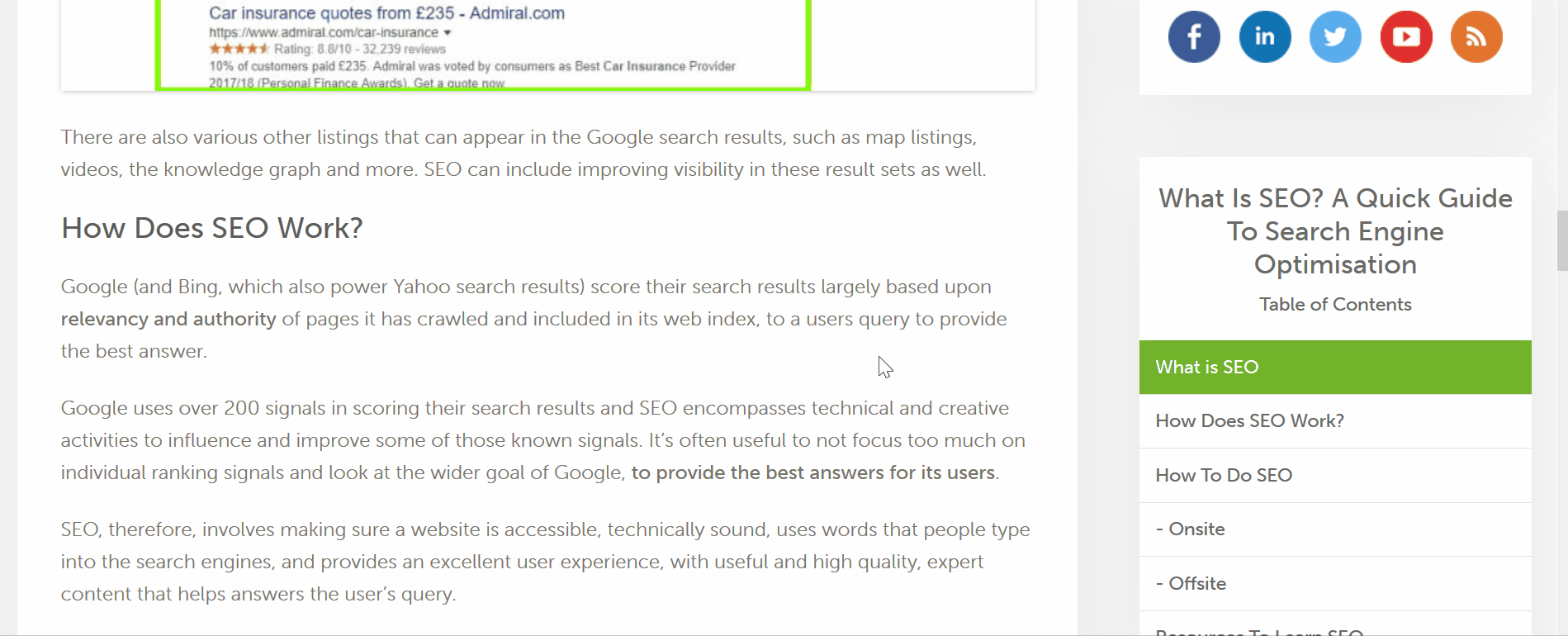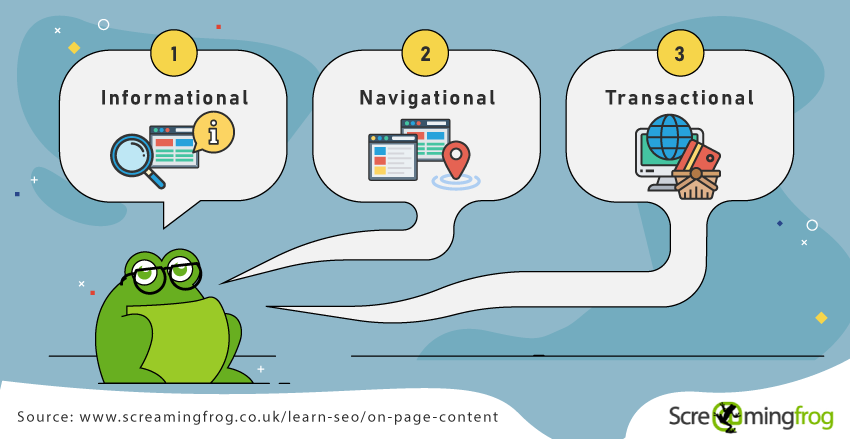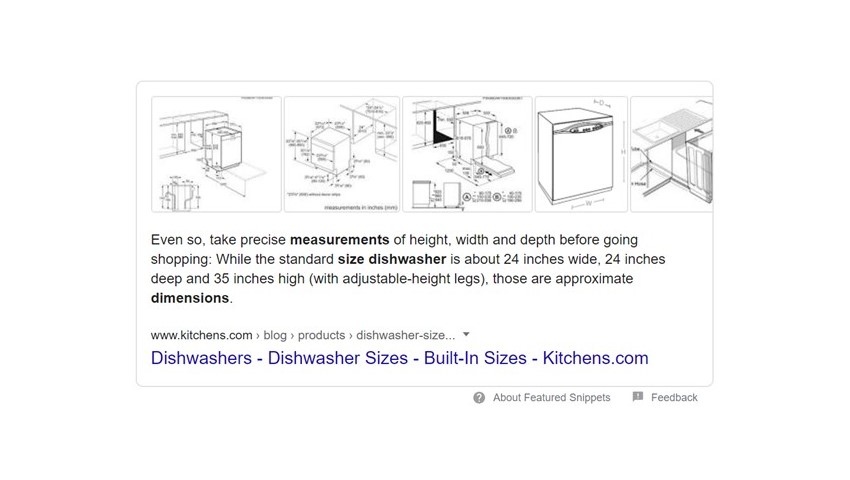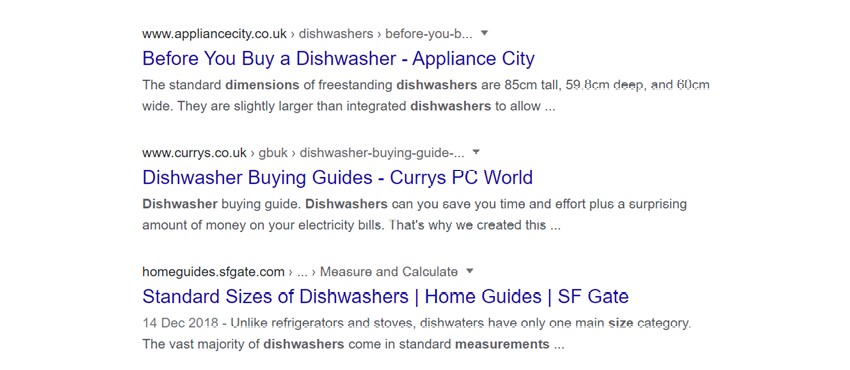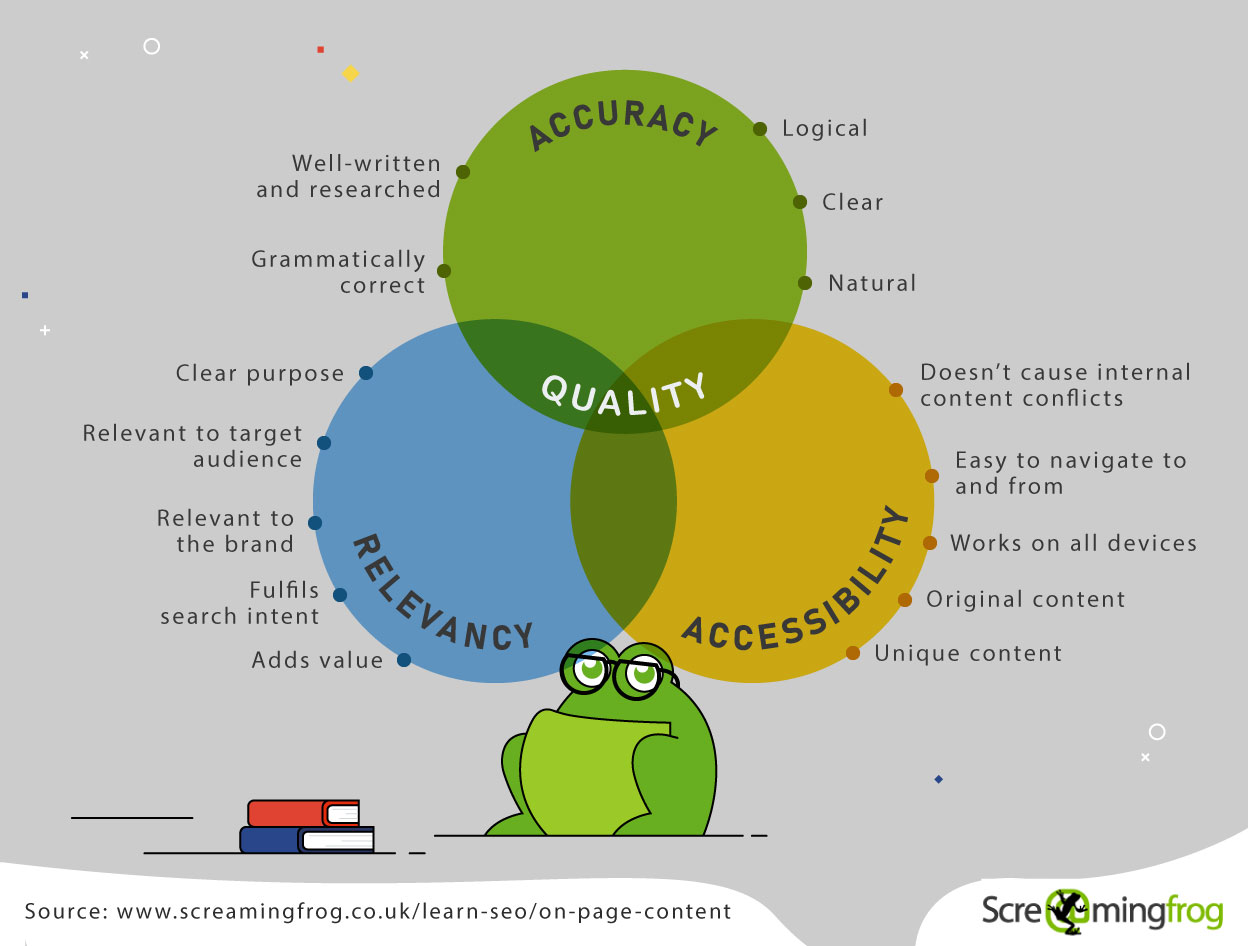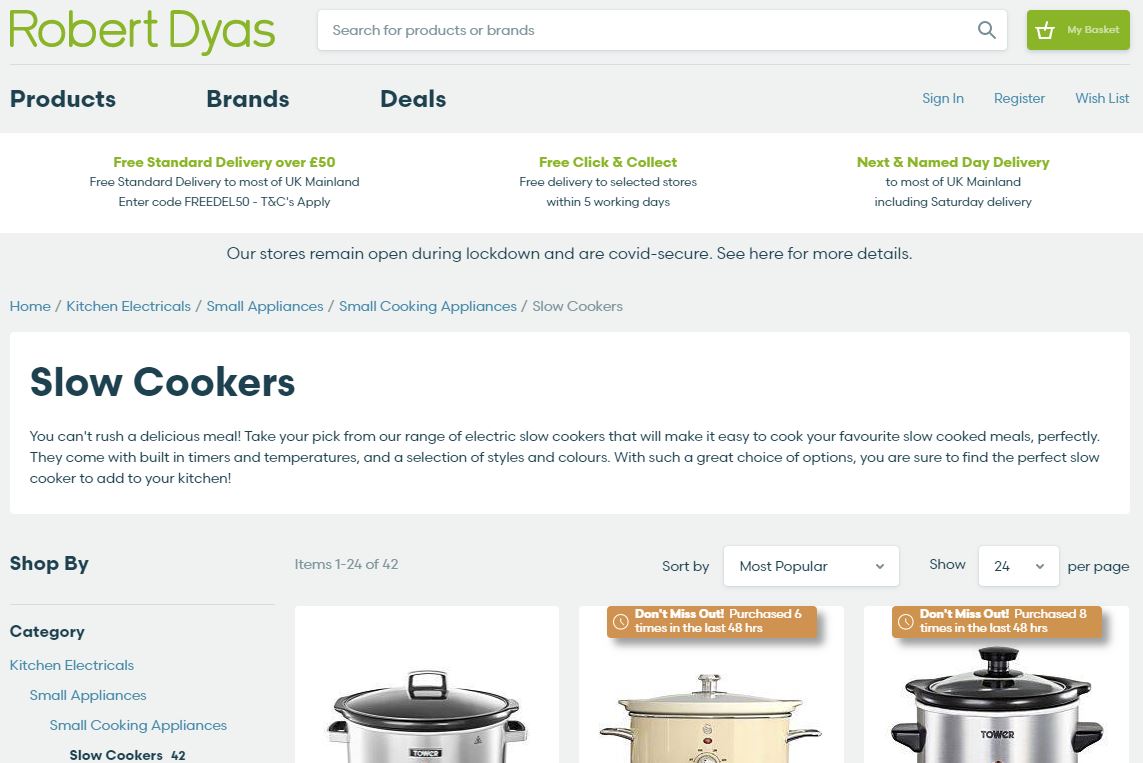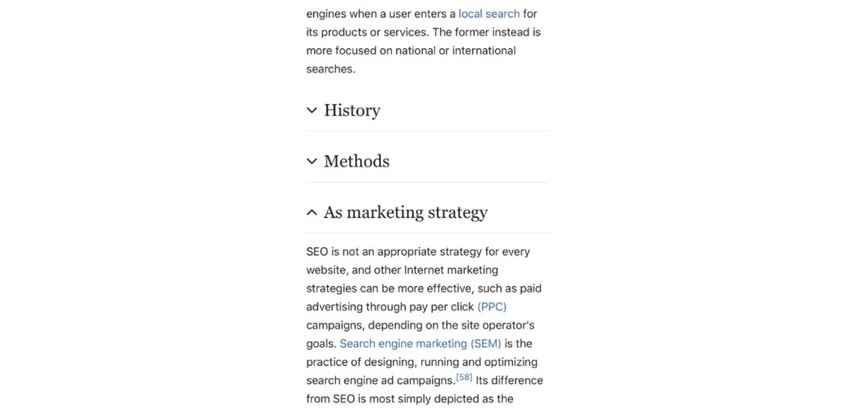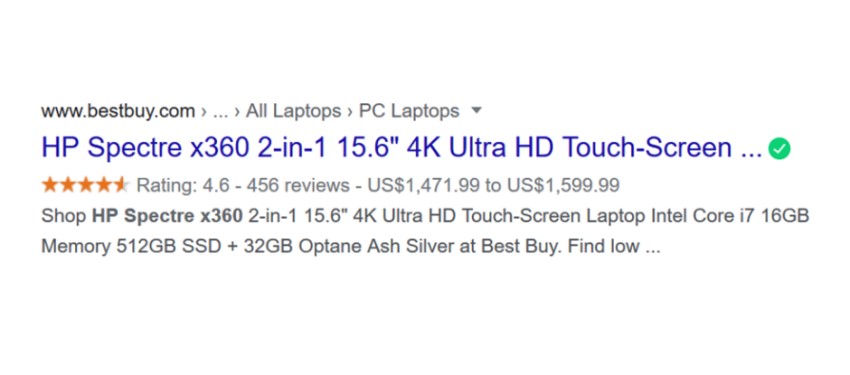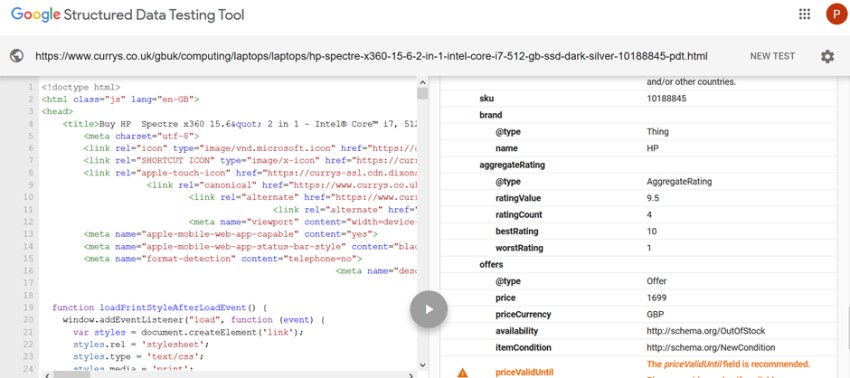On-Page Content
On-Page Content
Table of Contents
- On-Page Content Basics - 4 mins
- Content Quality - 6 mins
- On-Page Content Tips - 11 mins
- How to Audit On-Site Content - 7 mins
- Final Thoughts - 1 min
Understanding the role and importance of on-page content is critical to achieving SEO success. Ensuring your web pages have the right type and right amount of on-page content is important for both search engines and for users.
In this guide we take you through the fundamentals, as well as more advanced considerations and tactics when analysing and optimising your on-page content.
On-Page Content Basics
What is on-page content?
On-page content is a component of on-page SEO, focusing on the content which features directly on a web page and is visible to users. On-page content can include many different elements: text, images, products, videos, tables, and much more. Think of on-page content as essentially the core focus and purpose of a webpage.
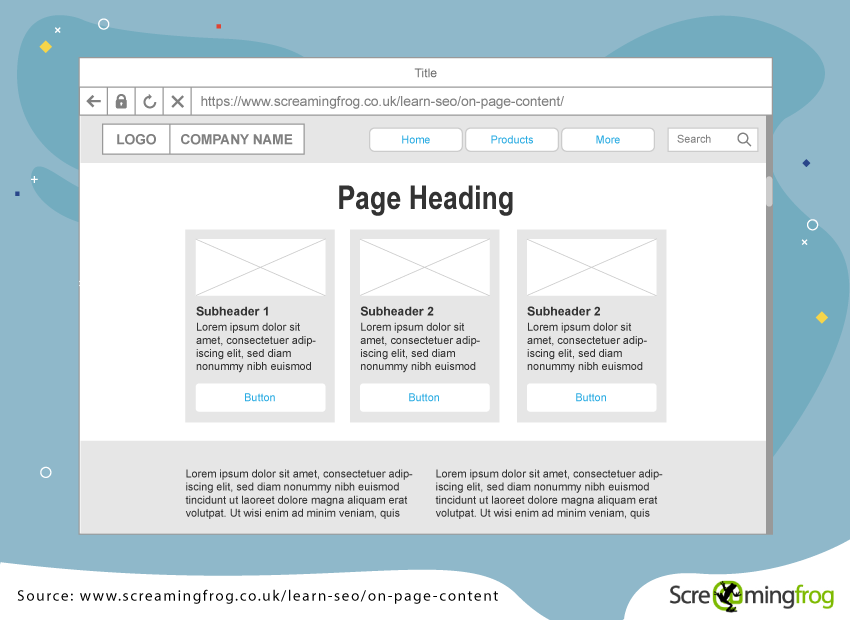
Where Does on-Page Content Go?
On-page content sits within the body of a web page, within the HTML container. This can be viewed in the HTML using a browser. You can right click on the web page and choose ‘view page source’ to view the raw HTML, or ‘inspect’ element to view the rendered HTML. You’ll see something similar to the screenshot below:
Is On-Page Content and On-Page SEO the Same Thing?
On-page SEO is a broader topic which also encompasses other elements such as page titles, meta descriptions, and headings. On-page content is a single component of on-page SEO.
Why Is On-Page Content Important?
On-page content is important because it relates significantly to how a page performs within organic search. Search engines evaluate the content of pages to understand their relevancy to specific search queries. If your on-page content doesn’t adequately reflect and target a particular search query, it’s unlikely to rank for it. For example, if you wanted a page to rank for the keyword ‘wireless headphones’, you would need it to include text about wireless headphones, images of them, technical specifications on makes and models, and so on.
On-page content is important for users too. Pages need to have the right type of content to fulfil user expectations, or they risk having poor user engagement and failing in their purpose. It’s critical that on-page content matches user intent.
What is User Intent?
User intent is an important topic to understand, especially in its relation to on-page content. User intent (sometimes known as ‘search intent’) is the concept of understanding what search users are trying to achieve or find from their search query.
In recent years, as search engines have become more sophisticated, they have become better at understanding user intent. They are now able to provide more accurate and reliable search results to satisfy user intent. Google even highlight the importance of user intent in their Search Quality Evaluator Guidelines:
User intent can be split broadly into three main query types:
- Informational – queries where users are looking for information on a topic or the answer to a particular question. For example –
- ‘how to change a tyre’
- ‘dishwasher dimensions’
- ‘how old is the queen’
- Navigational – queries where users are looking to navigate to a specific website, often a well-known brand. For example –
- ‘facebook’
- ‘twitter login’
- ‘contact expedia’
- Transactional – queries where users have a strong commercial intent, or that are likely to result in purchases or conversions. For example –
- ‘60 inch television’
- ‘travel insurance quotes’
- ‘seo services‘
It’s important to consider user intent in relation to on-page content to ensure that a page has the right type of on-page content to satisfy the matching user intent.
What Type of On-Page Content Do I Need?
The type of on-page content a given page needs depends on its intended purpose and how this relates to relevant search queries. You need to ensure that pages have the right type of content to fulfil user and search engine expectations. One of the best tools to help answer this question is search engines themselves.
By manually running searches for your target keywords in search engines, you get a good demonstration of how search intent relates to on-page content. From the search result you can analyse the types of pages ranking well for certain query types, which should help inform the type of on-page content you might require in order to compete.
For example, if a user searches Google using the query ‘dishwasher dimensions’, within the search results Google is first giving users a featured snippet with a carousel of diagrams and measurements of dishwashers, such as the example below:
The carousel of diagrams indicates that Google understands that for this search query, these types of images are useful in fulfilling the search intent. Hence, if you wished to target ‘dishwasher dimensions’ and other queries of this type, it might make sense to create a similar dimension diagram and include it on your page.
The ranking URL in the featured snippet is a blog post which explains the common dishwasher sizes and dimensions, and the page itself includes a table comparing the different common types and their measurements.
Below the featured snippet, all the top-ranking organic results are dishwasher buying and advice guides, which attempt to answer the original search query:
This is useful evidence of the type of page you might need to create and the type of on-page content required in order to compete. There are of course many other factors as to why those particular pages and websites rank highly, but what they share in common is the same type of on-page content.
This is an example of informational pages being the best answer to an informational search query. Similarly, for more transactional-intent queries like ‘black slimline dishwashers’, a user might expect to see an e-commerce category or product page, both of which are transactional in search intent, matching the transactional query type.
Above all, it’s important that each page has a clear purpose, search intent and target audience to ensure the on-page content accurately reflects this.
Content Quality
If you’re learning and reading about on-page content, you’ll probably hear the phrase ‘content quality’ before long. There is a lot written and discussed around content quality, so let’s try and break down the key points.
Google Quality Guidelines
A good place to start is by reading Google’s quality guidelines. It breaks down the key guidelines to be aware of in respect to on-page content, and outlines Google’s rules and policies with respect to content. Some of the key guidelines are –
- Automatically generated and scraped content – as a general rule of thumb, if on-page content hasn’t been written by a human, and/or if it’s been scraped and taken from elsewhere without any added value, it isn’t going to be regarded as quality content. Ensuring on-page content is unique and original is best practice.
- Doorway pages – pages created to try and rank for specific search queries, but at the detriment of overall user experience. Doorway pages are pages which are very similar and are created to funnel users to a single useful final destination, acting simply as a ‘doorway’ to acquire those users. An example might be a service business who serve customers all across the UK, but operate out of a single location. They might decide to create lots of location-focused pages which promote their service in different locations, but the service is the same no matter the location. If those location pages have similar or duplicate on-page content, provide little unique value to the user, and operate purely to try and rank better for locally-focused keywords, it’s possible they might be seen by search engines as doorway pages (especially if they are implemented at significant scale). If so, they might struggle to perform well as search engines will devalue them.
- Cloaking – the practice of serving different content or URLs to users as to search engines. It’s critical that your on-page content is consistent for both, so that both users and search engines see the same content. Cloaking isn’t always done deliberately or with malicious intent – it can happen by mistake, often by websites which utilise new technologies such as JavaScript. To make sure this doesn’t happen to you, you can audit JavaScript websites using the SEO Spider, and view the rendered page screenshots directly to ensure search engines see the same on-page content as users do.
Google Search Quality Evaluator Guidelines
Alongside the above quality guidelines from Google, it’s worth becoming familiar with their Search Quality Evaluator guidelines.
These guidelines are a working document that Google search quality evaluators use to measure content. The document is updated periodically, so it’s a good one to bookmark for future reference.
The guidelines contain lots of useful information on content, such as –
- Search intent and webpage purpose
- ‘Your Money or Your Life’ pages (YMYL)
- Main Content (MC) vs Supplementary Content (SC)
- Expertise, Authoritativeness and Trustworthiness (E-A-T)
These are all pillars of how Google measures content. The guidelines also include lots of useful examples of what constitutes Highest / High / Medium / Low / Lowest quality content, which can be useful to refer to when measuring your own content.
Thin and Duplicate Content
There are a number of common on-page content issues which come under the quality bracket –
- Duplicate content – where the same content can be found on multiple URLs. If there is not a clear hierarchy in terms of one page being linked to more, then search engines can have difficulty picking which URL should be ranking. This can cause internal conflict and cannibalisation (when two or more pages compete in ranking for the same keywords), in turn affecting ranking performance. An example of duplicate content is where two identical versions of the same page exist, but the URLs are slightly different – for instance one has a trailing slash and one does not (a common issue).
- Thin content – content that is presented in multiple different ways, meaning that the volume of this ‘remixed’ content ends up far outweighing the original unique content. It can also be when a single page is adding very little value to the user in terms of functionality or resource. This can be a problem if search engines, particularly Google, do not think a large enough proportion of the site provides any value to the user. This can then cause overall issues with the website’s rankings.
- Similar content – like duplicate content, similar content can be an issue where there are pages of a similar function or are targeted towards similar terms and it is not clear to Google which page should be ranking. An example of similar content are doorway pages, as outlined above.
Being aware of the above common issues is recommended when planning or writing on-page content.
Google Quality Algorithm Updates
Google typically releases one or more changes to its ranking algorithm every day in an effort to continually improve its search results. There are constant tests and iterations happening at an enormous scale to improve the algorithm.
In addition, there are also bigger, more periodic changes to Google’s algorithm which are known as ‘updates’ within the SEO industry. This is where Google update the algorithm and this has a much bigger and more noticeable impact on the search results, sometimes significantly changing how websites rank. For example, the visibility graph below from SISTRIX shows a website being heavily affected by notable algorithm updates (the blue markers on the graph):
Historically, there have been many different types of algorithm updates. Each one was designed to target a different aspect of search, and most were assigned memorable names either by Google or the SEO industry. For instance, algorithm updates like ‘Penguin’ targeted link spam, while updates like ‘Panda’ targeted thin and duplicate content.
Today, Google have been able to incorporate lots of those historical updates which focused on particular aspects of search, directly into their core algorithm. This is generally a good thing as it means challenges like link spam and duplicate content are addressed within the wider algorithm, with more regular tweaks and improvements being made. There are still notable periodical updates of this type, known as Google core algorithm updates.
The core algorithm updates typically happen several times a year, and are sometimes announced slightly in advance by Google. As expected, Google don’t comment on what specific changes they’ve made to the algorithm, but do provide broad advice to webmasters within their blog post on the subject.
Google’s silence doesn’t stop those in the SEO industry from running their own analysis and commentary on the core updates though, and it’s generally accepted that they seem to consistently target aspects like –
- Content quality (most similar to what the Panda updates did historically)
- Search intent and relevancy – ensuring the right types of pages rank for queries
- YMYL pages – ensuring high-ranking YMYL pages provide a high level of E-A-T
- E-A-T in general
- User satisfaction
This list is speculative and likely not exhaustive, but should help to give you an idea of what to review from an on-page perspective if you’ve been negatively affected by a core update.
How to Measure Content Quality
Considering all we’ve covered about content quality in this guide, a valid question to ask is – how do you measure content quality?
There isn’t a single metric or test which can be applied to tell what level of quality a given page is. Instead, a blended view of metrics, questions and considerations can act as useful indicators.
- Accuracy
- Is the content well-written and researched?
- Is it grammatically correct?
- Is it easy to follow and read logically?
- Is it clear?
- Does it read naturally?
- Relevancy
- Does the content have a clear purpose?
- Is it relevant to your target audience?
- Is it relevant to your brand?
- Does it fulfil search intent?
- Does it add genuine value to the user?
- Accessibility
- Is the content unique?
- Is the content original?
- Does it cause internal content conflicts with existing content?
- Is it easy to navigate to and from?
- Does it work well and is it fast on all device types?
Measuring your content against these points, as well as those in the Search Quality Evaluator guidelines and Google’s core algorithm update blog post, should help you to determine if your content is of a high-quality standard.
On-Page Content Tips
We’ve covered some of the basics of on-page content, as well as how Google approaches content, so let’s dig into some specific tips and answer other common questions or misconceptions!
How Many Words Do I Need For Good on-Page Content?
As a general rule, there is no optimal length or minimum word count for good on-page content. Depending on the intended purpose of a given page and how this relates to search intent, sometimes a page with very few words is more optimal. It might provide a better experience and a more relevant result than a page with lots of unnecessary text, which provides little or no value to the user. On other occasions, the ‘best’ page for a particular query type might require lots of in-depth analysis and commentary, which is best articulated by lots of text.
Within e-commerce specifically, there is debate in the SEO industry as to the effectiveness and importance of text on product category and subcategory pages. This is sometimes cynically known as ‘SEO text’, as many ecommerce sites feel the need to add a paragraph of introductory text to category pages in the belief this will help the pages rank better in organic search. Below is an example of this, from the Robert Dyas slow cookers category page:
Below the main heading on the page is a paragraph of ‘SEO text’, which sits above the range of products and their filters. Having such text on a page is fine or even advantageous if it is providing value and helping to inform users, but not if it is in the detriment of the overall user experience.
If implemented sensibly and intelligently, text on e-commerce pages of this type can be a good opportunity to –
- Target long-tail keyword variations
- Explain how the products work and their use cases
- Internally link to related pages (similar/related products, buyer’s guides, popular brands etc.)
- Answer common questions and provide advice
Ultimately, any text included on any page should serve a clear use and purpose to users, and shouldn’t exist solely for SEO. We recommend undertaking competitor research and SERP analysis to understand what type of on-page content you might require to best compete for target keywords.
How Does Google Treat on-Page Hidden, Tabbed, and Collapsible Content?
Firstly, there is a distinction to make around the different types of ‘hidden’ content. Hidden content which is hidden to try and manipulate rankings and can be seen as deceptive, is in violation to Google’s guidelines and risks penalisation. For instance, using white text on a white background, using images or CSS to hide text from users, or other types of cloaking, are all against Google’s quality guidelines and are not advised.
On-page content which is hidden or collapsible for the purposes of making the content easier to navigate and digest, for a better user experience, is perfectly fine. This approach is fairly typical across the web today, particularly as more users browse the web on mobile devices with smaller screen sizes. This approach is how well-established sites like Wikipedia handle their content on mobile, as we can see in the screenshot below:
Provided the tabbed content is configured correctly from a technical perspective, search engines are able to crawl and index it perfectly fine. Google have stated that hidden content may not be used as frequently in SERP snippets, but it will be crawled, indexed, and scored as normal.
How you present content on a page is also a user experience consideration, so we recommend testing and measuring to see how users react to your content. This will help ensure your content is presented in the best way possible.
Structured Data
Depending on the type of on-page content you have, you might be able to utilise structured data for additional SEO benefit.
Structured data is a format for providing information about a page and classifying the page content. For example, on a recipe page you’d have information such as: what are the ingredients, the cooking time and temperature, the calories, and so on. Read more to understand how structured data works in Google’s own guide.
Implementing structured data helps to give search engines additional information about your content, as well as the context of it too. It can also help to achieve rich snippets in the search results, such as review stars and product pricing information:
This helps the search listing stand out and catch a user’s attention, likely helping to increase click-through rate (CTR) from the search results.
Read more on guidelines for structured data here, and you can test structured data of a page using Google’s Structured Data Testing Tool:
You can also test and validate structured data using the Screaming Frog SEO Spider.
Keyword Density
Keyword density is the concept of how often a particular keyword is used on a given web page as a percentage or ratio of the total word count. For example, if a page has 1,000 words and a particular keyword is used 10 times, then it has a keyword density of 1% (or 1:100).
Historically, there has been debate in the SEO industry around the ideal keyword density per page, but this is a myth. There is no such metric acknowledged to be used by search engines in scoring, and there is no hard and fast rule for the amount of times you should use a particular keyword on a page.
That said, naturally using relevant keywords in a sensible and useful way for users is a good practice to follow when writing content for pages. We certainly recommend ensuring that your key target keyword is used on each page, ideally in the first paragraph of the page to highlight its importance to search engines.
Keyword Stuffing
Keyword stuffing is a practice of stuffing a page with text or numbers in an attempt to manipulate a site’s ranking in organic search. An example might be where a keyword or phrase is repeated many times to the point of it reading unnaturally. Google’s own example in their quality guidelines is:
“We sell custom cigar humidors. Our custom cigar humidors are handmade. If you’re thinking of buying a custom cigar humidor, please contact our custom cigar humidor specialists at custom.cigar.humidors@example.com.”
Keyword stuffing is against Google’s quality guidelines. At best it is ineffectual, and at worst it could risk manual penalisation from Google. Filling pages with keywords or numbers can result in a negative user experience and can harm your site’s rankings. We recommend creating useful, information-rich on-page content that uses keywords appropriately and in context.
How to Scale On-Page Content
Scaling content is a challenge that a lot of websites face. Creating original, unique, and valuable content at a high volume is not an easy or cheap task.
There are some common cases where scaling pages can be a challenge from an on-page content perspective. Let’s try and address a few and how you can think about tackling them –
- Product pages – e-commerce sites with many products often face the challenge of creating unique content for product pages. This problem can be exacerbated by products which are available in different forms – colours, sizes etc. Furthermore, there is an obvious temptation to use product description information from manufacturers, causing a potential duplicate content issue.
- Solution – one solution is to try and embrace user-generated content (UGC) in the form of product reviews. If you can encourage reviews from your customers, you can add these to the corresponding product page as unique, original and relevant content. As a bonus, these reviews can be marked up with structured data to try and achieve rich snippet review stars in the search results.
- Location pages – service businesses or shops with brick-and-mortar locations often require a dedicated page per location, but it’s likely the goods or services they offer won’t vary drastically from location to location. Hence, making these pages unique can be a challenge.
- Solution – try to include as much information or content which is unique to the location:
- List of areas covered (towns, cities, areas)
- Locally focused offers or deals
- Case studies, testimonials, and reviews relevant to the location
- Address, directions, local transport links, and parking information
- Interview with brand manager or staff
- Photos and videos of the location
- Contact details of local staff
- Local community involvement such as charitable causes and events
- Solution – try to include as much information or content which is unique to the location:
- Category pages – as outlined earlier in this guide, it can sometimes be a challenge to know what on-page text content to include on e-commerce category pages (particularly when at scale). It can be tempting to add boilerplate ‘SEO text’ just for the sake of it, which is likely to provide little SEO value and little value to users. Instead, try and think of this as an opportunity to add genuinely useful and relevant on-page content.
- Solution – create on-page content that:
- Targets long-tail keyword variations of your main target keyword
- Explains how the products work and their common use cases
- Internally link to related pages (similar/related products, buyer’s guides, popular brands etc.)
- Answer common questions and provide advice
- Solution – create on-page content that:
These are just some examples of common challenges scaling on-page content. Unfortunately, there aren’t easy or quick solutions to doing this, but we recommend really investing in your on-page content for long-term SEO benefits.
How to Write Great on-Page SEO Content
When it comes to writing great on-page SEO content, it can be intimidating to know where to start. It’s hard to give broad advice on writing given the vast amount of different pages you might need to write content for. For instance, an e-commerce product page will understandably require a very different type of writing, compared to a long-form evergreen advice guide.

That said, the following checklist and guidelines should hopefully be applicable to writing content for pages of all types:
- Establish Your Purpose and Target Audience
Every page on a website should have a clear purpose and target audience. It’s important to establish this before you start writing to ensure your content is as relevant and efficient as possible. You should consider factors of your target users like demographics, gender and age, as well as what action you intend for them to take when they’re on the page. Once established, this will allow you to use the right type of language and structure to best target that audience and overall objective. - Keyword Research
Undertaking keyword research is of fundamental importance when writing on-page SEO content. Whether you’re writing content for an existing page or content for a brand new page, you need to understand what keywords users are searching for relating to that particular subject. We’ve already established in this guide that keyword stuffing and keyword density are not advisable strategies, but naturally using relevant keywords related to your topic is still good practice for SEO. We certainly recommend using the target keyword naturally on each page, ideally in the first paragraph to highlight its importance to search engines. - Competitor Analysis
It’s worth reviewing similar pages by competitors to get an understanding of the wider competitive landscape. We recommend reviewing the top ranking pages for relevant keywords you intend to target, as this will help to inform your keyword research and understand what Google already regards as a ‘good’ search result for your target keywords. - Consider Page Templates and Layout
It’s a good idea to consider how your text will be displayed on the page before you start writing your content. This might help provide parameters to work within, such as a rough word count or thinking about how the content will be formatted (e.g. paragraph breaks). Think about how you want your text to be digested and make it as easy as possible for users to understand. - Find the Right Voice and Tone
Whether you have writing style guidelines already established or not, it’s useful to consider your writing in the context of the wider site. Consider what you’re trying to achieve with your text – the three search intent types (that we discussed earlier) can be useful in this, so that you’re using the right kind of language and tone to effectively articulate your points.
These 5 steps should help you to create quality and relevant on-page content!
What About Images and Videos as On-Page Content?
Most of the advice and recommendations in this guide have focused on text content, but on-page content encompasses anything that makes up a page, including images, video, and other rich media. There are some basic tips worth considering when adding images and video to your pages –
- Optimise Image Sizes and Types
Oversized images are one of the most frequent contributors to a slow website. Consider the need and use case of your images to help optimise their size. For example, images being used as a background or within a header image might not need to be as high quality as an image on an e-commerce product page, where users might want to see high-res images for close up detail of products. Use the Screaming Frog SEO Spider to find oversized images on your website, or connect the SEO Spider to the Google PageSpeed Insights API and pull in Lighthouse and Chrome User Experience Report data directly during a crawl. - Implement Image SEO
Follow image SEO best practices such as ensuring each image’s alt text (alternative text), image file name, image caption, and image URL are all descriptive and relevant to the image content. Image alt text is used within the HTML of a website to describe an image, principally for web accessibility (for the blind and visually impaired) or if the image cannot be displayed for some reason, as the text will appear in place of the image. It’s also used by search engines to understand the content of the image. Find images with missing alt text using the Screaming Frog SEO Spider. - Consider UX
Use images and rich media to enhance the experience for users. Images can add a further dimension to your content, and help to improve user experience and engagement. However, just like unnecessary text, don’t use images and video simply for the sake of it and at the detriment of the overall page purpose.
You can read more on image and video guidelines in the Google Help Center.
How to Audit On-Site Content
Auditing existing on-site content can be a big task to undertake. Depending on what issue(s) you want to analyse and what actions you’re looking to achieve, there are a number of methodologies to approaching an audit. Unfortunately, no single metric exists which tells you definitively that a page is underperforming or that its content could be improved. Instead, a blended view is most sensible and effective, supported by analysis, experience, and testing.
Below we’ve listed a number of content auditing tasks which can be valuable in uncovering poor-performing content which could be improved, or at least give you pages to prioritise reviewing from an on-page content perspective. This isn’t a definitive list, but it should help you get started!
Pages with poor user engagement
If a page has poor user engagement signals, this can be an indicator that it isn’t operating effectively in its intended purpose. Engagement signals such as bounce rate, time on site, and goal conversion rate can all be effective to measure this.
For instance, you can view landing pages in Google Analytics which have a high bounce rate from organic traffic –

Google Analytics > Reports > Acquisition > All Traffic > Channels > Organic Search > Primary Dimension: Landing Page > Behaviour: Bounce Rate
Here you might want to add some additional filters to show landing pages of certain sections of the website which are most important to you, or set thresholds for a minimum amount of sessions so you focus on high-priority pages. That’s what we’ve done here –

In the snapshot above, we have filtered landing pages to show category and subcategory pages within the /interior-lighting/ subfolder, and restricted to pages that have driven at least 100 organic sessions over the time period measured. The average bounce rate for pages of this type is 51.76%, so by sorting the pages by bounce rate, we can see pages that are above average. These might be pages to review to analyse if their on-page content can be improved somehow.
It’s important not to take a single user engagement metric like bounce rate as a definitive measure of quality or performance. Not only might a page with a high bounce rate be delivering a good experience for users, bounce rate in particular is a flawed metric which can be misinterpreted. Enabling adjusted bounce rate is a good start to providing a better metric, as well as setting up micro goals such as scroll depth trigger via Google Tag Manager.
Pages Which Rank Moderately for High-Volume Keywords
If you have pages which rank for relevant, high-volume keywords, but the ranking position is only moderately competitive, they might be pages where on-page content could be improved. The fact that the pages rank for relevant high-volume keywords is an indicator that search engines understand your pages to be relevant, but the moderate ranking position indicates that something might be holding the pages back. There are many potential reasons as to why the ranking positions might only be moderate, but on-page content is a likely contributor.
There are a number of tools you can use to get this data, such as SEMRush –

Domain Analytics > Organic Research > Positions: 11-20 > Volume: 10,001 – 100,000
In the snapshot above, we have filtered a site’s keywords to show those where they rank between 11th and 20th position, and keywords with between 10k and 100k average monthly searches in the UK. This filtering gives us a list of high-priority keywords for which the site almost ranks in the crucial top ten positions, and also which have significant search volume. Again, there could be many reasons as to why the site doesn’t rank in the top ten, but reviewing the on-page content of the associated pages is an advisable place to start.
Pages Which Rank for Lots of Keywords but Drive Relatively Little Traffic
Finding pages which rank for lots of keywords but that drive relatively little traffic can be valuable in auditing from an on-page content perspective. There might be simple tweaks to help pages to better target terms and also to make the pages more relevant to queries which they already rank for, thus improving organic ranking positions and increasing organic traffic.
There are a number of tools you can use to get this data, such as SISTRIX –
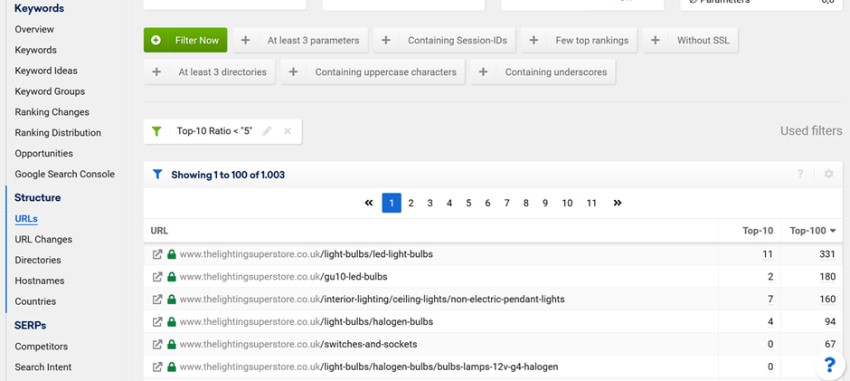
Structure > URLs > Filters: Few top rankings > Top-10 Ratio: less than 5
In the snapshot above, we have filtered this site’s URLs to show pages which rank for lots of keywords, but few in the competitive top ten ranking positions (generally the traffic-driving positions). For instance, the top URL ranks for 331 keywords in total, but only eleven of which are in the top ten ranking positions (less than 5%). It would be worth reviewing those keywords in more detail to understand if they can be better optimised from an on-page content perspective.
Finding Pages Where the Long-Tail Keywords Could Increase
Finding pages which already drive substantial organic traffic, but for which the long-tail could increase, can sometimes be led by on-page content improvements.
What are long-tail keywords?
Long-tail keywords are longer and more specific keywords which are generally more targeted to a specific user intent or action. For example, a main topic might be ‘televisions’, which is itself a high search volume and generic keyword (sometimes known as ‘fat head’ keywords) with many possible types of search intent. More specific and targeted keywords on the topic, such as ’60 inch OLED samsung tvs’ or ‘best 56 inch tvs under 300’ are long-tail keywords. Long-tail keywords are lower in search volume and competition, and often have a stronger purchasing search intent – those examples indicate a user who has undertaken a certain level of research and are now more likely to make a purchase. Hence, long-tail keywords are important to optimise for, as they help drive a lot of commercial value.
If you have pages which you already know drive good traffic and commercial value, increasing the long-tail potential of them can result in driving more sales. There are a number of tools you can use to get this data, such as Google Search Console –
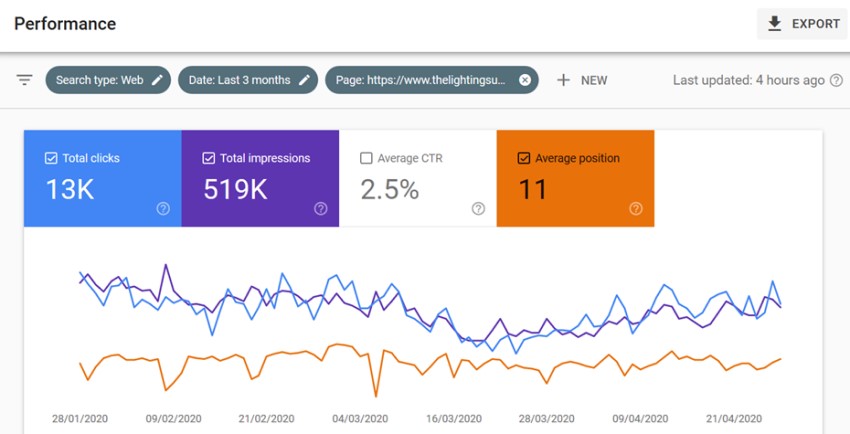
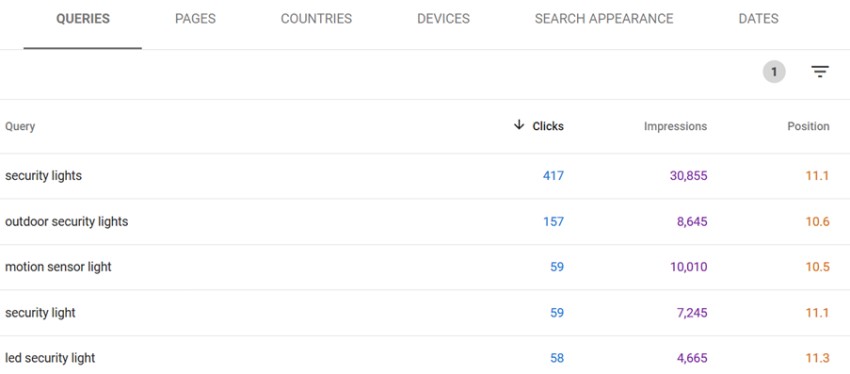
Follow these steps to get this data –
- Within Google Search Console, open the ‘Performance’ report.
- The report defaults to showing ‘Queries’ – change this to ‘Pages’.
- The report defaults to sort pages by those driving the most clicks. Click on the row of a page which already drives lots of clicks – perhaps a key category or subcategory page.
- The report defaults to showing ‘Pages’ – change this back to ‘Queries’.
- Above the Clicks/Impressions line graph, click on ‘Average Position’ to add it to the graph.
- Return to Queries.
- Using the ‘Filter rows’ dropdown, click ‘Position’.
- The filter defaults to ‘Equals’ – change this to ‘Greater than’, and then enter ‘10’ in the field to the right.
- Click the ‘Done’ button.
Here you should have a list of queries for which a key page on your site ranks on average just outside of the crucial top ten ranking positions. You can review the page to analyse if it can be improved to better target these keywords, helping to improve their average ranking position, and drive more traffic.
Pages With a Low Word Count
While a crude and caveated metric in isolation, pages with an unusually low word count can sometimes be a clue to finding content which could be improved. By ‘unusually low word count’, we mean in comparison to other similar pages or what you might typically expect to see in terms of word count.
For example, if when auditing an e-commerce website you find that most of your product category pages contain 200-300 words, but you find some others with little or no text on them, these could be pages to review and consider adding descriptive text to. As outlined earlier in this guide, simply adding text to any page just for the sake of it is not a good strategy, but if useful to users and positive for the overall user experience, it can be very powerful.
You can pull the word count for pages using the Screaming Frog SEO Spider –
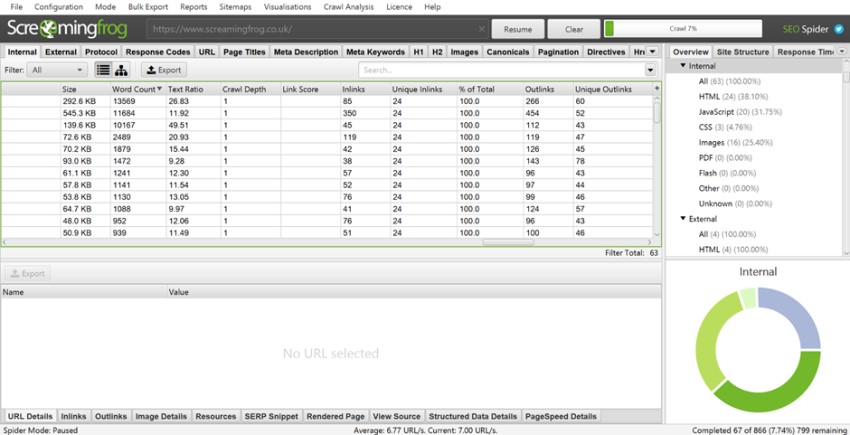
Mode: Spider > Crawl > Internal tab > Word Count column
In the snapshot above, we have crawled a site and navigated to the Word Count column within the Internal tab of the SEO Spider. Here you can sort the column or export the data, to show which pages have the lowest word counts. If the word count of a particular page is unusually low, this can prompt further investigation and potentially on-page content improvements.
Final Thoughts
On-page content is a vast topic that touches on lots of different areas of SEO, but we hope that our guide has provided a useful overview of the key foundations.
On-page content is arguably more important than ever to SEO success. Search engines have become increasingly sophisticated and users more demanding with higher expectations, so it’s critical that on-page content delivers in every respect.
If your content fundamentally doesn’t have a clear purpose, a clear search intent, or if it doesn’t deliver and fulfil user expectations, there’s a good chance it won’t rank competitively in organic search. By making sure you are following the best practises highlighted in this guide, you’ll be giving your pages the best chance of competing and being set up for users and search engines alike.

